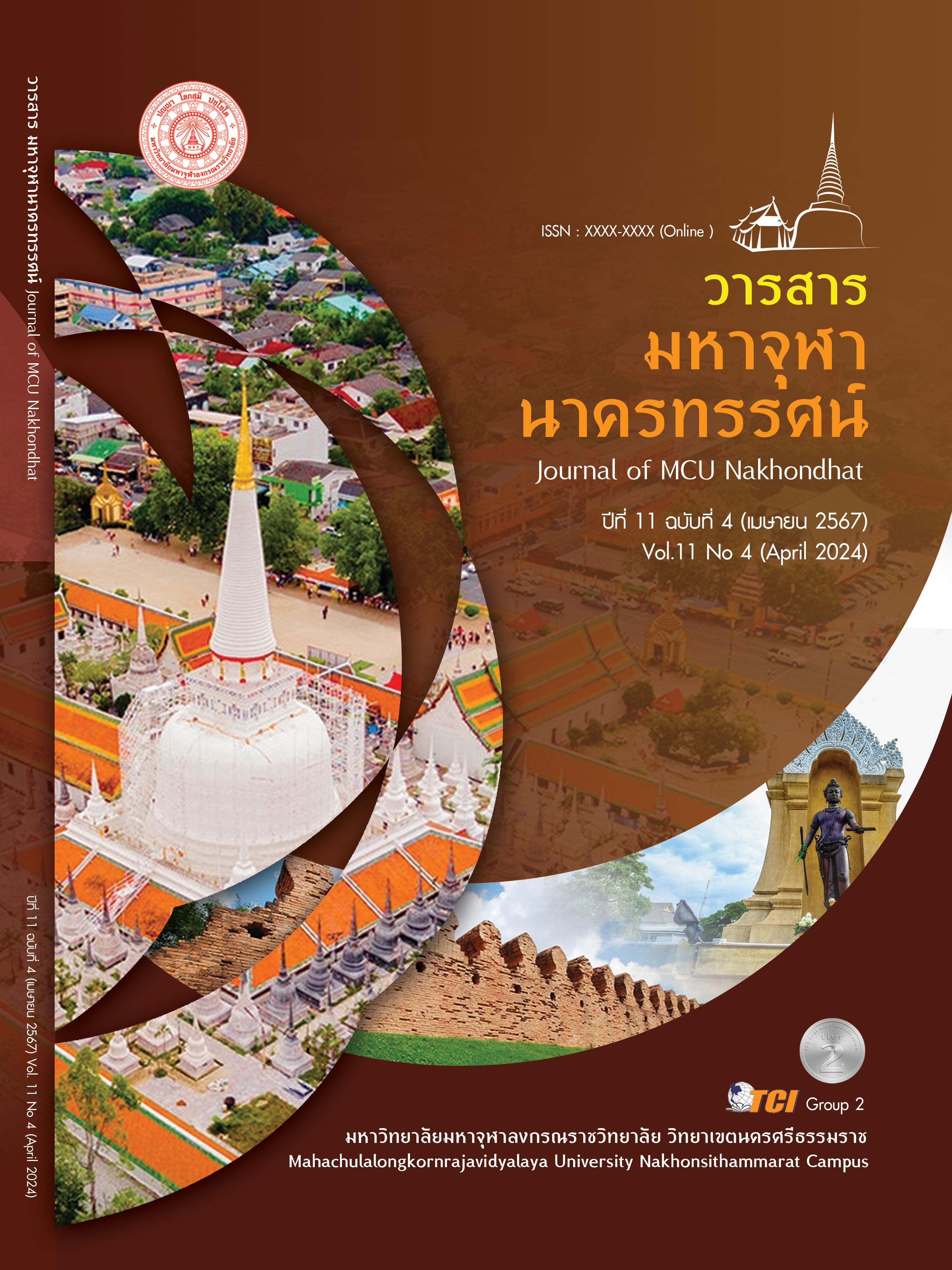A STUDY OF THE CONCEPTUAL METAPHOR OF “酸 SUĀN SOUR” IN CHINESE
Main Article Content
Abstract
This research aims to study the types of conceptual metaphors of “酸” in Chinese and analyze the conceptual metaphors of “酸” in Chinese by using a qualitative research model and using the cognitive linguistics theory based on the ideas of Lakoff and Johnson. Collection of data on words and expressions containing “酸” From 5 dictionaries and 2 online dictionaries. Data were analyzed to select a total of 53 words and 20 expressions containing conceptual metaphors, and sample sentences were collected from the Peking University data warehouse website. The research results found that the conceptual metaphors of “酸” in Chinese can be classified into 10 categories: 1) sorrow and suffering; 2) envy and jealousy; 3) obsoleteness; 4) physical aches and pains 5) unpleasant smells; 6) rotten things; 7) sarcasm; 8) haughtiness, arrogance; 9) arrogance Various flavors of life and 10) pretending. And by analyze the conceptual metaphor of “酸” in Chinese, it was found that word combinations are used to expand the scope of word usage. There is a way of using metaphors for things related to humans, such as hearing, seeing, character traits, mental aspects, emotions, etc. which is related to human senses, including touch, taste, smell, hearing and vision. It shows that most of them are human metaphors or human stories. It also expresses the meaning of things that make you unhappy.
Article Details

This work is licensed under a Creative Commons Attribution-NonCommercial-NoDerivatives 4.0 International License.
References
กรกนก รัมมะอัตถ์. (2556). การเปรียบเทียบอุปลักษณ์ความรักในเพลงไทยลูกทุ่งกับเพลงไทยสากล. ใน วิทยานิพนธ์การศึกษามหาบัณฑิต สาขาวิชาภาษาไทย. มหาวิทยาลัยศรีนคริทรวโรฒ.
ชัชวดี ศรลัมพ์. (2548). อุปลักษณ์ตามแนวคิดของทฤษฎีภาษาศาสตร์ปริชาน. วารสารศิลปะศาสตร์, 5(1), 1-16.
ชาสินี สำราญอินทร์ และคณะ. (2561). อุปลักษณ์เชิงมโนทัศน์ในบทเพลงเทิดพระเกียรติแด่พระบาทสมเด็จพระปรมินทรมหาภูมิพลอดุลยเดช. ใน วิทยานิพนธ์มหาบัณฑิต สาขาศิลปศาสตร์. มหาวิทยาลัยเทคโนโลยีราชมงคลสุวรรณภูมิ.
ทัศนีย์ เมฆถาวรวัฒนา. (2553). ทฤษฎีอุปลักษณ์ตามแนวคิดแบบดั้งเดิมและแนวคิดแบบใหม่. วารสารสงขลานครินทร์ ฉบับสังคมศาสตร์และมนุษยศาสตร์, 16(5), 837-845.
ปัญจพล บุญมา. (2565). อิทธิพลของชนิดในการใช้คำอุปลักษณ์บริบทและวัฒนธรรมที่ส่งผลต่อการตีความของผู้เรียน. วารสารภาษา ศาสนา และวัฒนธรรม, 11(2), 30-53.
ราชบัณฑิตยสถาน. (2554). พจนานุกรมฉบับราชบัณฑิตยสถาน. (พิมพ์ครั้งที่ 2). กรุงเทพมหานคร: นานมีบุ๊คส์พับลิเคชั่น.
วศิน สุขสมบูรณ์วงศ์. (2563). การศึกษาความเข้าใจคำอุปลักษณ์สชาติของอาหารในภาษาจีนของนักศึกษาสาขาวิชาภาษาจีน มหาวิทยาลัยราชภัฏพิบูลสงคราม. วารสารวิชาการคณะมนุษยศาสตร์และสังคมศาสตร์, 11(1), 61-74.
Huang. X. J. (2015). A comparative analysis of the conceptual metaphors of “Spicy” taste in Chinese and English. Journal of Hubei University of Science and technology, 35(5). 82-90.
Lakoff, G., & Johnson, M. (1980). The metaphorical structure of the human conceptual system. Cognitive Science, 4(2), 195-208.
Li. Q. M. (2021). A comparative study on synesthetic metaphors of taste words in Chinese and Spanish. Liaoning: Journal of Liaoning University of Education Administration, 2021(1), 89-99.
Li. Y. X. (2011). A comparative analysis of English and Chinese taste words from the perspective of conceptual metaphor theory. Journal of Mudanjiang University, 20(6), 66-78.
Saeed, J. I. (1997). Semantics. London: Blackwell Publishers Ltd.
Xiong.Y. (2018). A cross-cultural study of taste metaphors. Overseas English, 2018(5). 221-229.


